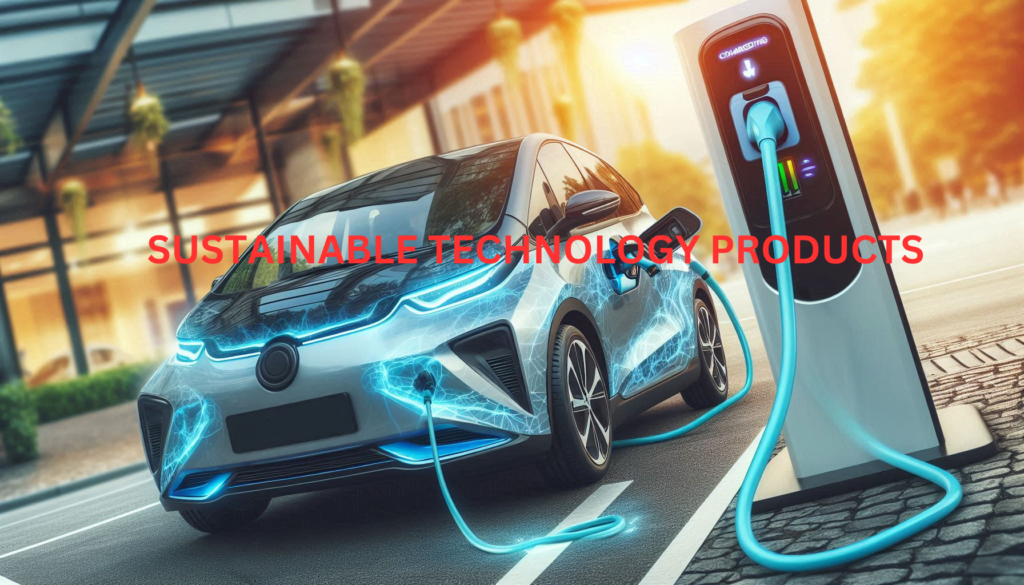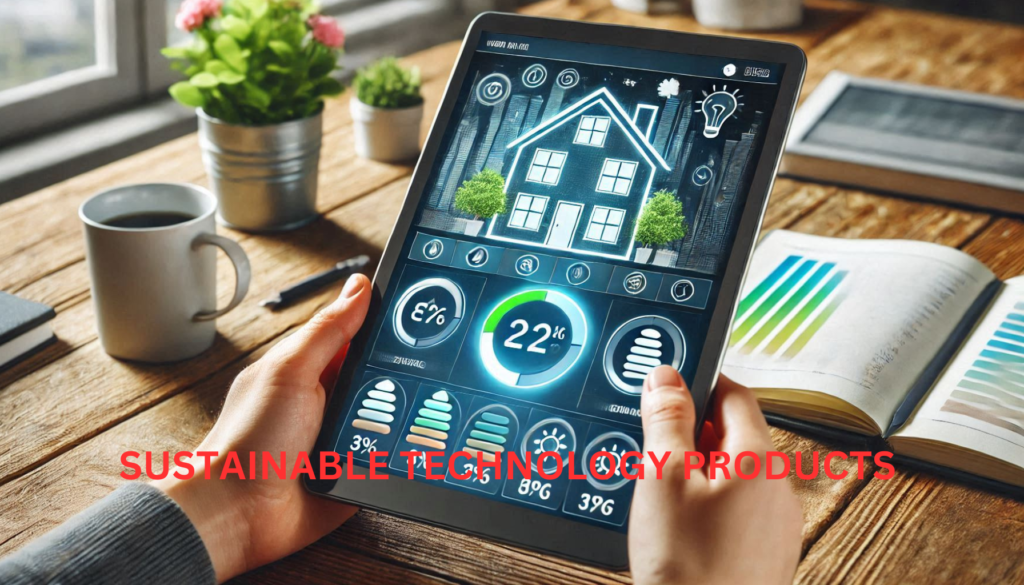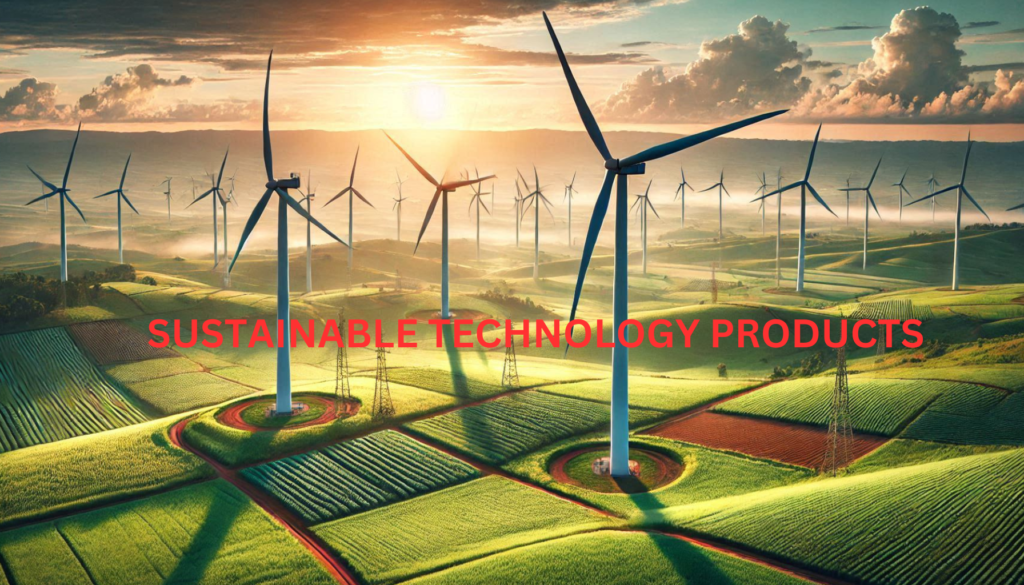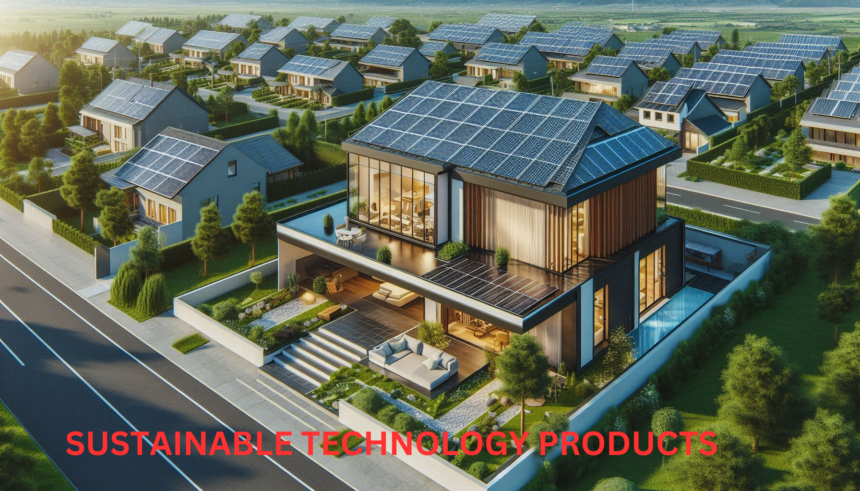In recent years, sustainable technology products have gained a lot of attention in talks about climate change and future innovations. As we head into 2024, it’s crucial to assess whether these products are genuinely promoting sustainability or just providing short-term fixes for more significant environmental issues. This article will examine the benefits, challenges, and impact of sustainable technology in 2024.
What Are Sustainable Technology Products?
Sustainable technology products are new ideas made to lower environmental damage, use energy better, and encourage the use of resources that can be replaced. These products are used in many different areas, like energy, transportation, electronics, and farming. The main aim is to develop things that are good for the environment, responsible, socially beneficial, and good for business.
Key examples include:
- Electric vehicles (EVs)
- Solar panels and wind turbines
- Energy-efficient appliances
- Biodegradable packaging
- Smart home devices designed to optimize energy use
Benefits of Sustainable Technology Products
- Environmental Impact Reduction
- A big advantage of sustainable technology products is that it helps cut down on carbon emissions and the harm we do to the environment. Things like solar panels and wind energy turbines, renewable energy, which means we use less dirty fuel from the ground.
- Electric vehicles (EVs), which don’t give off any pollution from their exhaust, are another way technology helps keep our cleaner environment. They not only make our carbon footprint smaller but also help clear the air.
- Energy Efficiency
- Sustainable technology products usually focus on energy efficiency. Items like Smart thermostats, LED lights, and smart home systems help people use less energy, which lowers their electric bills and helps the environment.
- In buildings and factories, using energy-efficient products and methods helps reduce waste and makes effective resource use.
- Economic Benefits
- The demand for sustainable technology products has grown a lot. By 2024, the worldwide global renewable energy market is expected to be worth over $1.5 trillion. This shows that these technologies help the environment and also create jobs.
- Advances in clean technology have led to new industries and business ideas, providing green jobs in fields like research, development, installation, and upkeep.
- Resource Conservation
- Sustainable tech products usually use renewable resources, such as solar energy or biodegradable material, which helps save precious natural resources. Additionally, technologies that support a circular economy, where products are reused or recycled, cut down on waste and decrease the need for new materials.

Challenges of Sustainable Technology Products
Although sustainable technology products offer many advantages, there are also several obstacles that need to be overcome to make the most of their potential:
- High Initial Costs
- A big reason why more people don’t use eco-friendly technology is because of its high initial cost. For instance, electric vehicles (EVs) are better for the environment over time, but they can be much more expensive than regular cars. Also, things like solar panels or wind turbines usually require a big initial investment.
- Even though these technologies save money and help the environmental benefits in the long run, the initial financial hurdle is still a worry for many people and companies.
- Limited Accessibility and Infrastructure
- In many places, the infrastructure for sustainable technologies are not underdeveloped or don’t exist at all. For example, there are few electric EV charging stations in rural or distant areas, which makes it hard for people to use electric cars.
- Also, solar energy systems might not work well in areas with less sunlight, which limits how much they can be used.
- Environmental Impact of Manufacturing
- sustainable technology products aim to lessen long-term environmental harm, but the methods used to make them can still cause significant environmental issues. For instance, making solar panels involves mining materials like silicon, silver, and rare earth metals, which can harm ecosystems if not managed carefully.
- Electric vehicle batteries also need metals like lithium, cobalt, and nickel, which are often mined in ways that cause environmental degradation and human rights abuses in some regions.
- Short Lifespan and E-Waste
- Many sustainable Technology products, like smart gadgets and energy-efficient electronics, often don’t last very long, which causes issues with electronic waste. When these products stop working or become outdated, they can damage the environment if they aren’t recycled correctly.
Progress and Pitfalls of Sustainable Technology Products in Detail
Progress of Sustainable Technology Products
- Reduction in Environmental Impact
The main reason sustainable technology products ability to mitigate is because they help fight climate change. Items like electric cars and solar panels are greatly decreasing our use of fossil fuels, which means less carbon is released into the air. This makes these technologies very important for worldwide efforts to lower greenhouse gas emissions and slow down global warming. For instance, electric cars not only reduce exhaust emissions but also help clean the air, which is a big issue in cities. - Energy Efficiency
A big improvement in using smart home technology and energy-efficient products has made daily use of resources much more sustainable. Tools like smart thermostats, LED lights, and smart meters are helping homes and businesses use less energy. These technologies make heating, cooling, and lighting systems use less energy while still keeping things comfortable. - Economic Growth and Job Creation
The growth of the clean energy sector has created many new economic chances. Companies that work on solar power, wind energy, and sustainable manufacturing have led to a big increase in jobs related to the environment. By 2024, the worldwide global renewable energy market is expected to keep expanding, offering more economic opportunities and helping to solve climate issues. As people and businesses buy more green products, this change is also making jobs in areas like research, making things, setting things up, and keeping things running for sustainable technologies. - Innovation and Technological Advancements
sustainable technology products keeps improving. New ideas like solar roofs, electronics that break down naturally, and products made from recycled materials are changing how we think about saving resources. Also, improvements in battery technology are making it easier to store renewable energy, which helps with the problem of solar and wind power not being available all the time. These developments show that sustainable technology is more effective and can be used in many different fields.
Pitfalls of Sustainable Technology Products
- High Upfront Costs
A big reason why more people don’t use sustainable technology products is because they cost a lot at first. Even though things like electric vehicles or solar panel installations cost money over time, the starting price can be too high for some people or businesses, especially in poorer areas. For example, even though solar panels have become cheaper, they are still a big expense for many homeowners, even with discounts or help from the government. - Limited Infrastructure
The systems needed to support eco-friendly technologies are not yet fully developed in many places. For electric vehicles, the network of charging infrastructure is still growing, and in many rural or distant areas, there are very few charging points. Likewise, while solar power can be very useful, it doesn’t work well in areas with little sunlight or poor electricity connections. Without the right systems in place, it’s hard for these green technologies to become common. - Environmental Impact of Manufacturing
Even though sustainable tech products are made to lower long-term environmental harm, their production still has big environmental costs. For instance, making electric vehicle batteries and solar panels needs minerals like lithium, cobalt, and nickel. These minerals are usually mined in ways that hurt ecosystems and raise worries about worker conditions. Also, mining these materials can lead to deforestation and soil erosion, which goes against the very goals these technologies are trying to reach. - E-Waste and Product Lifespan
Many sustainable tech products such as smart devices, wearable gadgets, and home appliances, have short lifespans and add to electronic waste. As these technologies advance rapidly, older versions become outdated, and people throw them away. This creates worries about how to recycle or dispose of e-waste in a way that is good for the environment. Even products made to save energy can harm the environment if not managed correctly when they reach the end of their useful life. - Over-Promising and Under-Delivering
Some sustainable technology products are advertised as the best way to solve environmental issues, but they might not always deliver on what they promise. For example, some eco-friendly technologies might not work as well as they say, or they might not be as reliable or perform as well as people expect. While many sustainable products have potential, they often have teething problems, such as software glitches in smart home gadgets or high maintenance costs in energy systems.

Impact of Sustainable Technology Products
The impact of sustainable technology products in 2024 is very strong, changing businesses, economies, and our surroundings. These products, like electric cars, smart home devices, and renewable energy systems, aim to greatly help the environmental benefits and open up new opportunities in the market. But, the full effect of these eco-friendly technologies relies on solving current problems and making sure they are used by many people. Here are some main effects of eco-friendly technology products:
- Reduction in Carbon Footprint
One of the biggest benefits of sustainable technology products is that they help cut down on carbon emissions. The use of electric cars and the growth of solar energy have been key in lowering the amount of greenhouse gases released in the transportation and energy fields. As more people and companies choose to use these green technologies, the overall amount of carbon produced by industries and homes is greatly reduced. This is very important in the effort to stop climate change. - Energy Efficiency and Savings
Sustainable technology New devices, like smart thermostats and LED lights, help people and companies use less energy while still being comfortable. These tools are made to use energy wisely by changing settings based on current information and working at their best. This means people can save money on their energy bills over time, making these devices good for the environment and good for their wallets. - Economic Growth and Job Creation
The expansion of environmentally friendly businesses has resulted in many new job openings in areas like renewable energy, sustainable production, and green construction. In 2024, the market for clean energy keeps growing, offering sustainable job options worldwide. As governments and companies focus on making their activities more sustainable, fields like solar panel installation, battery manufacturing, and recycling have generated millions of jobs. This economic development is important for building a stronger global economy. - Technological Innovation and Advancement
Sustainable technologies are leading to new ideas in many areas. For example, smart grids help spread renewable energy more efficiently, and better battery storage makes solar and wind energy more dependable. Other innovations, like carbon capture and biodegradable electronics, are also important because they help cut down on waste and lessen the harm technology can do to the environment. These improvements are crucial for creating a more sustainable world. - Challenges to Mass Adoption
Even though sustainable technologies have many benefits, they are not widely used yet because of some problems. High starting costs, not enough support systems, and difficulties in making these technologies are some of the issues. For example, electric cars are getting cheaper, but there are not enough places to charge them, especially in the countryside or in poorer countries. Also, even though solar panels save money over time, the cost to set them up can be too high for some people, especially those with lower incomes. - Environmental Impact of Manufacturing
A big effect of making sustainable technology products is the harm to the environment during production. Items like electric vehicle batteries and solar panels need special materials like lithium, cobalt, and nickel, which are hard to get and can hurt the environment. Mining these materials can lead to soil loss, cutting down trees, and harming nearby nature. As more people want these tech products, it’s very important to get these materials in a safe way and to have ways to recycle them to keep everything sustainable.

The Future of Sustainable Technology Products: What’s Next in 2024 and Beyond?
The outlook for sustainable technology products in 2024 and later is very positive. As more people, companies, and governments work towards reaching net-zero emissions and lowering their impact on the environment, these technologies will keep improving and becoming a normal part of everyday life. Here are some important trends that will shape the future of sustainable technology:
1. Increased Integration of Renewable Energy Sources
The future of sustainable technology depends a lot on using energy from sources like solar, wind, and water. As we make better solar panels, wind turbines, and ways to store energy, more people will start using clean energy. For example, making solar power work better and connecting it to smart grids will help spread energy more evenly, so more homes and businesses can use renewable energy.
2. Smart Cities and Green Urban Planning
The idea of smart cities—places where sustainable technologies are used—is likely to become very important in the future. These cities will use technologies like IoT sensors, smart infrastructure, and energy-saving buildings to use less energy and manage resources better. In these eco-friendly urban areas, waste management, transportation, and energy use will be improved, making living spaces more sustainable.
Smart home technologies will also become more popular, with people using devices like smart thermostats, energy-efficient appliances, and automated lighting to reduce their impact on the environment. As smart cities grow, the future of sustainable technology will greatly influence how we live, work, and interact with our surroundings.
3. Sustainable Transportation Solutions
The transportation industry is set to change a lot with the increase in electric cars and autonomous electric vehicles. In the future, electric cars will be cheaper, better, and easier to use, which will lower the world’s need for fossil fuels. The growth of places to charge electric cars and ways to recycle car batteries will help make transportation more sustainable.
Also, new types of alternative fuel sources, like cars that run on hydrogen, will help cut down on carbon emissions from transportation. Self-driving cars will be important in using less fuel and reducing traffic jams, which will help create a more sustainable future.
4. Circular Economy and Product Lifecycle Management
As companies focus more on sustainability, we’ll see more use of circular economy ideas. This means making products that can be used again, recycled, and made in ways that don’t harm the environment. Products will be built to last longer, be easy to fix, and be recyclable, which will cut down on electronic waste and make products last longer.
For instance, smart gadgets will be made to work for a longer time, and companies will provide ways to upgrade services so they last even longer. Also, as 3D printing becomes more common, we’ll be able to make eco-friendly products locally, which will lower the environmental harm caused by long shipping routes.
Conclusion
In 2024, sustainable technology products are very important in the worldwide effort to protect the environment. These products can greatly lower the amount of carbon we produce, use resources more wisely, and help fight climate change. But, moving to these sustainable technologies isn’t easy. There are problems like high starting costs, technical issues, and the difficulty of getting everyone to use them, which can make it hard to succeed.
Even though there are difficulties, the good things that come from it in the future are much better than the problems. Sustainable technologies are improving quickly, and areas like energy, transportation, and farming are seeing new ideas that can help create a cleaner future. Renewable energy, electric cars, smart cities, and ways to capture carbon will be very important for the world of the future. To make this work, everyone—governments, businesses, and people—needs to work together to solve these problems and make the most of sustainable technology.
FAQs
1. What are sustainable technology products?
Sustainable technology products are innovations designed to reduce environmental impact, minimize resource usage, and promote eco-friendly practices. These products focus on improving energy efficiency, reducing waste, and utilizing renewable resources. Examples include solar panels, electric vehicles, energy-efficient appliances, and smart home systems.
2. How can sustainable technology help with climate change?
Sustainable technology products help reduce carbon emissions, improve resource management, and promote clean energy solutions. By replacing traditional energy systems and promoting environmentally-friendly alternatives, sustainable technologies can directly combat the factors contributing to climate change.
3. What are the challenges of adopting sustainable technology?
Some of the key challenges in adopting sustainable technologies include high initial costs, technological limitations, the need for infrastructure improvements, and consumer resistance. Additionally, the integration of these technologies into existing systems can be complex and time-consuming.
